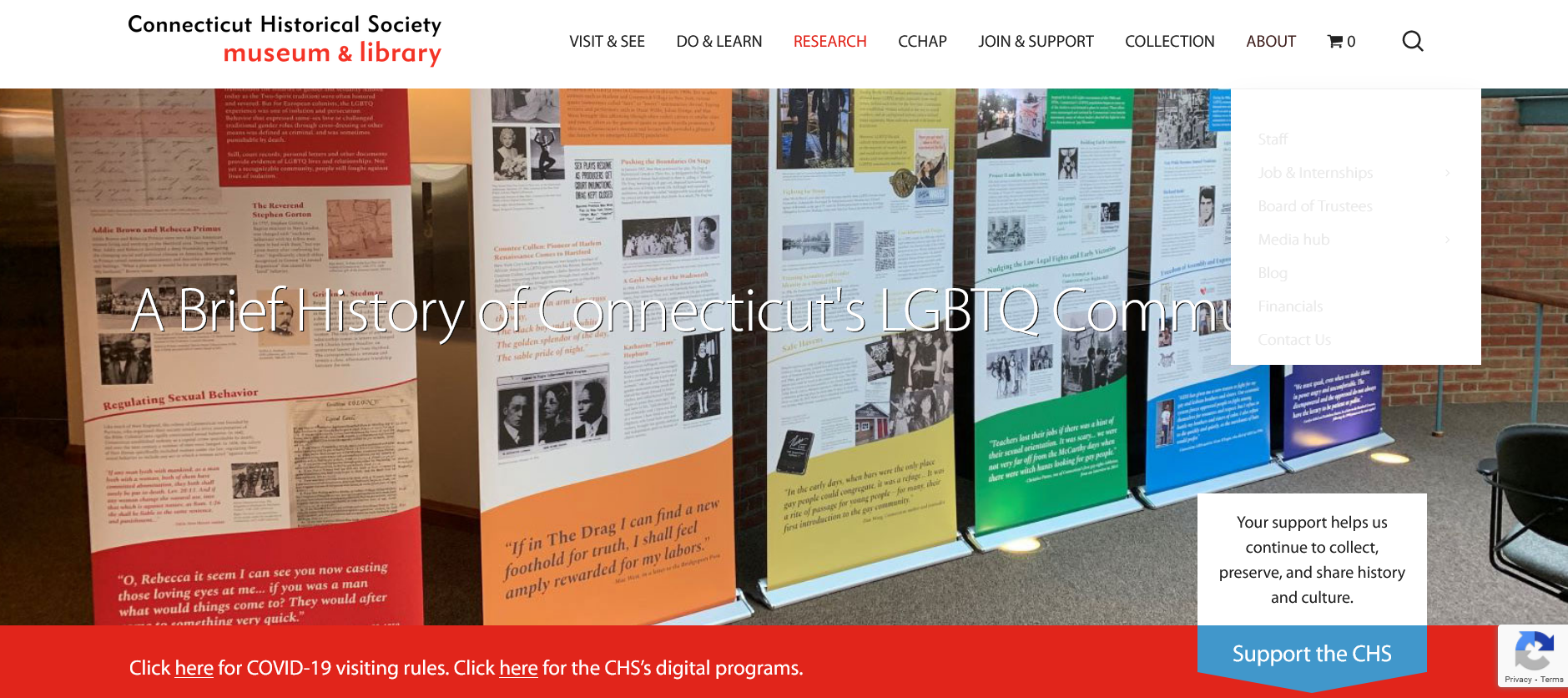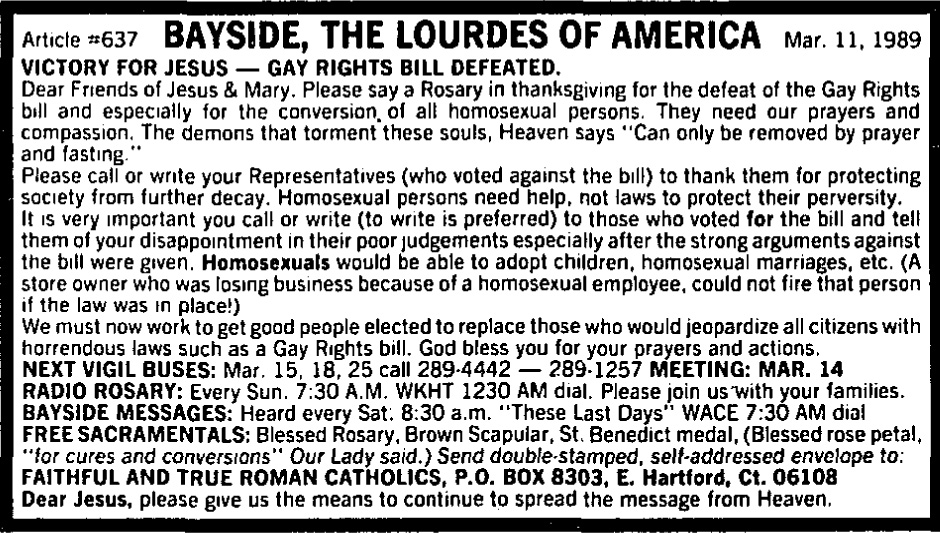Eve Galanis
Graduate Student, American Studies, Trinity College
TEACHER'S SNAPSHOT
Subjects:
Civil Rights, Law, LGBTQ+ History, Social Justice
Course Topics/Big Ideas:
Gender Roles in Economic, Political, and Social Life, The Struggle for Freedom, Equality, and Social Justice
Town:
Statewide
Grade:
High School
Lesson Plan Notes
Inspired by the civil rights movement, people in the LBGTQ+ community came together to organize for advocacy, acceptance, and visibility. While the Stonewall riots in 1969 were known for setting off the modern LGBTQ+ movement, Connecticut citizens were paving the way years earlier.
ESSENTIAL QUESTION
SUPPORTING QUESTIONS
- What were the positions of pro-LGBTQ+ organizations and activists in 20th-century Connecticut and how did they influence the local community?
- How was the LGBTQ+ community inspired by the civil rights movement?
- How did early LGBTQ+ advocacy groups shape state policy and social life in Connecticut?
ACTIVITY
In this lesson, you will examine the events that led to the modern LGBTQ+ movement in Connecticut.
Engage:
The Stonewall Riots was a monumental event in LGBTQ+ history.
While it occurred in New York City, its effects sent a ripple across the country.
Watch the video: “How the Stonewall Riots Sparked a Movement.” (3:54)
“Do Now” slip or discussion questions:
1. What was life like in the United States for LGBTQ+ people during the 1960s? Where did they go to seek haven?
2. Who owned The Stonewall Inn? Why was this important?
3. Describe the events that occurred on June 28, 1969. Why was this moment significant?
4. What was the lasting impact of the Stonewall riots?
Now we will examine how these events influenced Connecticut and the course of LGBTQ+ history in the state.
Explore:
Go to the Connecticut Museum of Culture and History’s “Historic Timeline of Connecticut’s LGBTQ Community.”
Click through and scan the “1970-Today” section.
What events occurred that led to future LGBTQ+ advancements?
Use a “Cause and Effect” graphic organizer to record your thoughts.
Explain:
Students get a copy of the Think–Pair–Share Worksheet. Teacher can distribute digitally or a paper copy.
Students partner for Think–Pair–Share activity.
Before reading, students answer the first question on the graphic organizer.
Together, they will read the 1991 Metroline article, “How the Gay Rights Bill Was Won.”
Students complete the “What I Thought” column independently.
As they share out their answers, their partner will record their findings in the column labeled, “What My Partner Thought.”
Together, through discussion of the reading, they record the third column labeled, “What we will share.”
Students will share out their findings to the class.
Extend:
Compare and contrast the “Victory for Jesus—Gay Rights Bill Defeated” paid advertisement from the Hartford Courant, published on March 11, 1989, with the “Where Do We Go From Here” editorial, published in Metroline in 1991.
Use this Written Document Analysis Worksheet or a Venn diagram to organize your thoughts as you analyze the texts.
OPPORTUNITIES FOR ASSESSMENT
Evaluate:
Imagine you are a Connecticut state legislator in 1989. The gay rights bill was just struck down again. You know that the issue of gay rights has been a controversial topic for decades at this point. You also know the Roman Catholic Church has strong organizational and political influence. After you’ve analyzed the sources we’ve examined in this lesson, you will answer the following:
- Summarize the two sides to the gay rights argument: the Roman Catholic Church position and the pro-gay rights stance.
- How will you vote? Defend your decision, using the texts and other information you know from the time period. Remember, you are legislator in 1989, not today.
- Now, pretend you are a legislator today voting on legislation banning conversations about LGBTQ+ identity in public schools. What would your decision be? What justification would you give? You must at least partly defend your decision by using historical information from the sources. You may also bring in more recent information as appropriate.
OR
Watch the video: “How Florida’s ‘Don’t Say Gay’ law regulates school lessons on gender, sexual orientation,” from PBS.
Imagine the Connecticut state legislature is proposing a similar “Don’t Say Gay” bill for public schools.
Write a speech taking a stance on the bill.
Do you believe this bill will do more good or more harm?
You must at least partly defend your decision by using historical information from the sources.
You may also bring in more recent information as appropriate.
RESOURCE TOOL KIT

“How the Stonewall Riots Sparked a Movement.” History Channel, June 1, 2018. (3:54)

“Historic Timeline of Connecticut’s LGBTQ Community.” Connecticut Museum of Culture and History.
Monteiro, Elsa and William J Mann. “How the Gay Rights Bill Was Won.” Metroline, Vol. 14, No. 9, May, 3, 1991, pgs. 16-20. GLBTQ+ archives, Central Connecticut State University.

“Victory for Jesus—Gay Rights Bill Defeated” paid advertisement, Hartford Courant, March 11, 1989.

“Where Do We Go From Here?” Metroline, pg. 4, Vol. 14, No. 9, May, 3, 1991. GLBTQ+ archives, Central Connecticut State University.
ADDITIONAL RESOURCES
Places to GO
GLBTQ+ Archives, Central Connecticut State University Library
Things To DO
Attend Pride events that typically occur June–September in cities throughout the state. Check for all-ages events in your area.
If your school does not have an LGBTQ+ organization club, consider forming one. Allyship and visibility is essential to promoting human rights and protecting LGBTQ+ youth from bullying and discrimination. How to Start a Gay-Straight Alliance (GSA), ACLU.
If you want to investigate LGBTQ+ history even further, check with your local historical society or library. LGBTQ+ historical research is challenging, especially the further back into history you go. Here is a guide to help you with your research: How to Look for Records Of: Sexuality and Gender Identity History. Note: While this source provided specifically grapples with UK-based history, the article is useful to help you identify and search for key terms pertaining to LGBTQ+ history.
Listen to a podcast:
- “Examining Connecticut’s LGBTQ+ History,” Where We Live, WNPR
- “Uncovering Connecticut’s LGBTQ+ History,” Connecticut Explored
Websites to VISIT
Historic Timeline of Connecticut’s LGBTQ Community, Connecticut Museum of Culture and History
History Day LGBTQ+ Topics, Connecticut State Library
LGBTQ+ History Primary Source Digital Archives, University of Washington Library Archive
WWUH, Gay Spirit Radio
Articles to READ
Craven, Tina Marie. “CT has historically been ahead of the curve in defending LGBTQ rights.” CTPost, June 18, 2021.
Wiginton, Keri. “From Stonewall to Today: 50+ Years of modern LGBTQ+ History.” stacker, November 14, 2022.
Dunne, Susan. “Gay Spirit Radio Was Connecticut’s ‘original Queer Social Media.’ It’s Celebrating 40 Years on Thanksgiving.” Hartford Courant, October 30, 2020.
Gifford, Emily. “An Early Advocate for Connecticut’s Gay Community.” Connecticut Explored, Summer 2014.
Galanis, Eve. “Canon Clinton Jones: A Revolutionary Figure in Connecticut’s LGBTQ+ History.” ConnecticutHistory.org, May 3, 2022.
Galanis, Eve. “Kalos Society: Connecticut’s First Modern LGBTQ+ Activist Organization.” ConnecticutHistory.org, June 1, 2022.
Wiley, Emma. “Eighteen Years in the Making: Connecticut’s 1991 Gay Rights Law.” ConnecticutHistory.org, November 16, 2021.
Pazniokas, Mark. “Senate Approves Gay Rights Bill.” Hartford Courant, April 18, 1991.
GLBTQ Legal Advocates & Defenders. “Connecticut: Overview of Legal Issues for Gay Men, Lesbians, Bisexuals, and Transgender People.” September 2018.
The Kalos Society-Gay Liberation Front. The Griffin: News of Gay Liberation, November 1971. Roz Payne Sixties Archive, Center for Digital Research in the Humanities, University of Nebraska-Lincoln.



